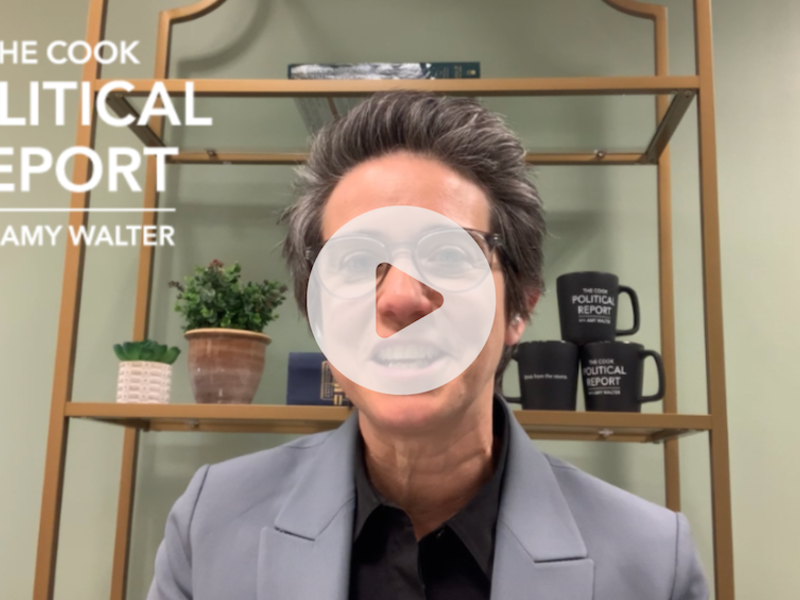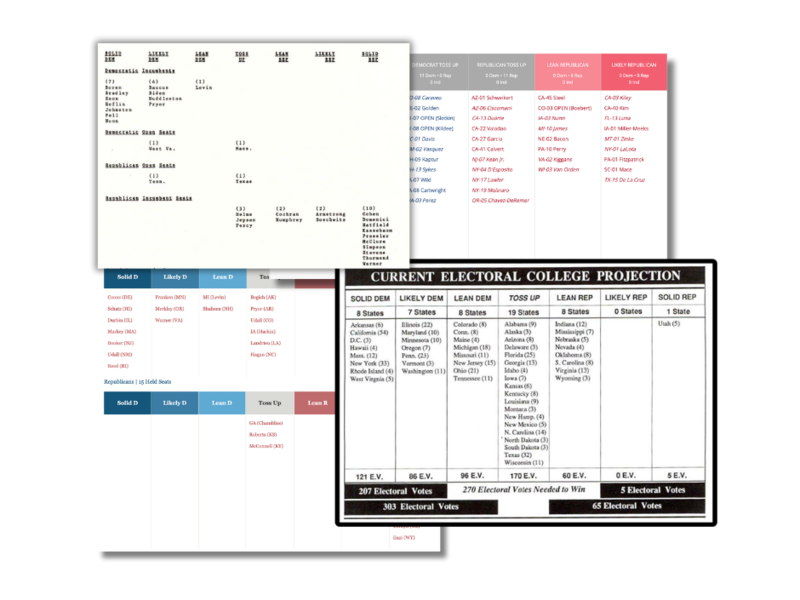
Not long after a presidential election, conventional wisdom sets in on how the losing party can win four years later. In 2013, for example, the RNC and the GOP "establishment" concluded that the only way for a Republican to win the White House in 2016 was for the nominee to broaden his/her appeal beyond their narrow base of older, white voters. In 1989, prominent Democratic voices Bill Galston and Elaine Kamarck concluded that the party, which had lost three straight presidential elections, was seen as "unacceptably liberal" and needed to move the center if their party was to win in 1992.
Of course, Donald Trump didn’t follow the RNC’s advice and won, while Bill Clinton followed the Galston/Kamarck advice and won.
This year, however, there are multiple theories as to how Democrats should run in 2020. One school of thought is for Democrats to win back the white, working-class voters that defected from Barack Obama/Bill Clinton to Trump in 2016. The other school, pushed by many on the left like Steve Phillips of the Center for American Progress, holds that Democrats lost in 2016 because they “prioritiz[ed] the pursuit of wavering whites over investing in and inspiring African-American voters, who made up 24 percent of Barack Obama’s winning coalition in 2012.” In other words, Democrats need to spend less time trying to woo white, working class voters and more time inspiring non-white millennials.
Meanwhile, the president continues to snub his nose at the advice to expand his base with an appeal to younger and non-white voters. His approval ratings among all but white, non-college educated voters are underwater. Can he really expect to win another election with this same strategy?
For the last four years, the Center for American Progress, Brookings Institution, the Bipartisan Policy Center (BPC) and the Public Religion Research Institute (PRRI) have teamed together to study the country’s changing demographics and its impact on electoral outcomes. The latest report, which was released earlier this week, ran presidential election simulations based on assumptions about “different demographic groups’ future voting patterns” and found that all three of these potential strategies can technically produce an Electoral College victory.
Let’s first look at potential Democratic strategies:
- The Stop Trying So Hard With Trump Defectors, Win More Black Voters Scenario: In this scenario, the Democratic nominee would not do any better among white, non-college voters than Hillary Clinton did in 2016. But, if the black turnout or margin or both are similar to 2012, a Democrat would win the popular vote by four to five points and the Electoral College with 294-338 votes. However, it does assume that a Democrat not named Barack Obama can hit Obama-like numbers among black voters.
- The Spend More Time In Scranton Scenario: Despite all the attention lavished on the influence of white, college-educated voters, white voters without a college degree comprise a bigger share of the electorate than the exit polls captured. The authors estimate that 44 percent of the electorate in 2016 was in this demographic group, compared to the 34 percent in the national exits. Democrats can’t afford to ignore — or lose ground with — these voters.
Even if they did no better among black and Hispanic voters than Clinton, Democrats could still easily capture the popular and Electoral College vote by either: 1) hitting 2012 levels of turnout and margin among white, non-college voters; or 2) increasing their vote among these voters by 10 points (+5D and -5R) from Clinton’s performance.
In scenario #1, hitting 2012 levels of support, a Democrat would carry the popular vote by 6 points and win the Electoral College 347-191. Not only would the Rust Belt states Clinton lost like Pennsylvania, Wisconsin and Michigan flip back to blue, but Democrats would also carry Florida and North Carolina. In scenario #2, where white non-college support shifts 10 points in Democrats favor, a Democrat wins the Electoral College with 334 Electoral votes, including states like Georgia and Florida. Interestingly, Ohio and Iowa would stay in the GOP camp.
However, can a candidate who could appeal to these voters — especially on social and cultural issues — win a Democratic party where the center of gravity on those issues has shifted even farther to the left since 2012? - The Suburban Mom Scenario: If 2018 is, as my colleague David Wasserman has predicted, the year of the angry, white, college graduate, perhaps 2020 can be as well. Trump won white college-educated voters, according to exit polls, by just three points. Today, Trump’s job approval rating among these voters is abysmal. In the most recent NBC/Wall Street Journal poll, only 36 percent of whites with a college degree give Trump a positive job rating, while 61 percent disapprove of the job he’s doing. Among college-educated white women, 72 percent disapprove of Trump. If these votes swung five points toward the Democrats and five points away from Republicans in 2020, a Democrat would win the popular vote by more than 6 points and win the Electoral College 334-204, including Georgia and Florida.
However, what if in winning more college-educated voters, a Democrat would turn off an equal number of non-college white voters? A version of “Deplorables” versus “Diplomas” that we saw in 2016. In one example that the authors of the report offered, Democrats improve with college-educated whites, while Republicans improve their performance among non-college educated whites by a similar amount. Under that scenario, Republicans would still narrowly win the Electoral College, while losing the popular vote by a little more than a point.
And, here are some of the potential GOP strategies:
- The Trump “More Cowbell” Scenario: We all know that Trump’s presidency has been dedicated to keeping his base happy. But, is this a politically sustainable path for 2020? In one simulation, the answer is no. Holding 2016 performance constant, demographic changes alone would tip the Electoral College away from Trump, with a Democrat carrying Michigan, Pennsylvania and Wisconsin by less than a point each. If, however, you re-allocate the third party vote of 2016 to a partisan choice (ie, move Jill Stein voters to Democrats and Gary Johnson voters to Republicans), Democrats would still win the popular vote, but the Electoral College would be tied at 269-269. If we assume that Maine’s 2nd district once again votes Republican, the GOP would win the Electoral College.
This is not a sustainable strategy for Trump. It has zero room for error.
But, what if Trump does even better among those white, working class voters? If Trump improved his performance among these voters by 10 points (going from 66 percent of the vote to 72 percent while the Democrat drops from 29 percent to 24 percent), Trump would not only win the Electoral College with 329 votes but would also win the popular vote. In addition to holding Michigan, Pennsylvania and Wisconsin, states like New Hampshire, Minnesota, Nevada and Maine would also flip to red.
However, under this scenario, 2020 would serve as the last time a Republican would win the popular vote. And, that, says Democratic pollster Anna Greenberg, is a huge red flag. Greenberg, who wrote her own analysis of the data, writes that “in four presidential cycles (2024, 2028, 2032, and 2036), Republicans would win the Electoral College while losing the popular vote." What would this do, she wonders, to the legitimacy of the presidency? To the future of the GOP or the rise of a serious third party? - The RNC Autopsy Scenario: Let’s pretend that the 2020 GOP candidate took the 2013 RNC document to heart and started to reach out to non-white voters. A 15-point swing among Hispanics, Asians, and those belonging to other racial groups toward the GOP candidate and away from the Democrat, “would create a narrow popular vote victory for the Democratic candidate — 0.8 points — but a robust 315-223 Republican victory in the Electoral College.” Even so, Republicans would continue to lose the popular vote by increasing margins over the next four presidential elections and ultimately lose the Electoral College in 2036. Maybe another candidate will pursue this path in the future. I highly doubt that we’ll see Trump take this strategy.
Bottom Line:
These scenarios are fun to play with, but not particularly realistic. After all, we know that every action has an equal and opposite reaction. Campaigns, said one consultant to the project, are like balloons. If you push down on one side, the other side is going to get bigger. It’s also hard to know if using 2016 as a ‘baseline’ for which to base future outcomes is all that helpful. After all, these were the two most disliked candidates in modern American history. Their performance — especially on the margins — can have as much to do with them as with the party.
However, it is also apparent that no matter which way you slice and dice the data, Republicans have a demographics problem. Of the sixteen different electorate simulations run, only one gave Republicans a popular vote victory. Even so, as RealClear Politics’ Sean Trende writes in his analysis of the data “One can certainly make a case that he [Trump] maxed out the white vote in 2016. Yet we have heard declarations of ‘last gasps’ for Republicans in 1994, 2002, 2004 and 2010. Perhaps we should simply call this ‘breathing.’”









Subscribe Today
Our subscribers have first access to individual race pages for each House, Senate and Governors race, which will include race ratings (each race is rated on a seven-point scale) and a narrative analysis pertaining to that race.